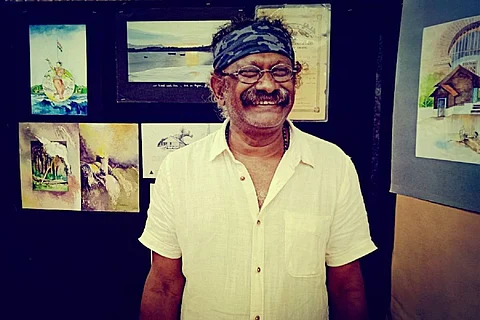

At a corner of the Thiruvananthapuram Museum Hall, placed on a stand, is a yellowed old certificate bearing the name G Kochukrishnan Pillai, as having passed the elementary examination in painting in 1912. Next to it is an oil sketch of land and sea in Port Blair, made in 1996, by G Narayana Kurup. Both exhibits stand out among the many paintings and sketches of SN Sreeprakash, son of Kurup and grandson of Pillai. Sreeprakash, running an exhibition of his artworks based on the Andaman and Nicobar Islands, says that he has been a statistician there for decades. It comes as a surprise for he has an abundance of artworks hanging in the hall, and in the scrapbook displayed on the table, apart from the many he hasn’t included for the show.
“I moved from Kerala to the Andaman in 1986, after finishing my MSc in Math and working in Keltron for two years. My sister and brother-in-law, who were then working in the Andaman told me not to come there and to finish my studies. But I was that kind of a person who’d roam like a kite in the sky,” Sreeprakash says, standing before the small family history he fitted into his exhibition.
His grandfather was also a mathematician and an artist, while his father, who worked as a tahsildar, dabbled in arts, and made an oil sketch of Port Blair during the month he visited Sreeprakash. In the Museum Hall, Sreeprakash has chosen to begin with the beautiful landscapes of Andaman, all captured in alluring oil paint. On the other side is a strange deviation from the calming landscapes, showing the cruel asides of colonial history – a hangman’s knot in thin air, the gallows, and the cellular jail that the British built to imprison Indians – all of them his water-colour paintings.
Pointing at the gallows, Sreeprakash says, “They’d hang seven people at a time and then celebrate in the evening.” His fingers move around to show the order of events. These sets of paintings were done as part of a film called Scream of Silence that Sreeprakash worked in.
He also has a few paintings of the women in Andaman – the new brides who come to live on these islands and make friends with the neighbours. His bride, Jayashree, had also come to the islands to join him in the early years. “She had been my lady love, then she became my everything,” the artist says with a rare blush.
He also has a Devadassi series, more abstract than his other works, and a painting bigger than the rest, dedicated to the COVID-19 times with a tribute to Florence Nightingale.
The slightly unexpected in the series of exhibits are the pen and pencil sketches covering the other side of the last stand, detailed in the lines and curves that you can imagine him quickly doodling. For he does that for you at the end of your visit – make live sketches of seagulls with a few strokes of his pen.
Sreeprakash’s exhibits end with a picture of Netaji Subash Chandra Bose coming to Port Blair in December 1943 to hoist the first tricolor flag in India.